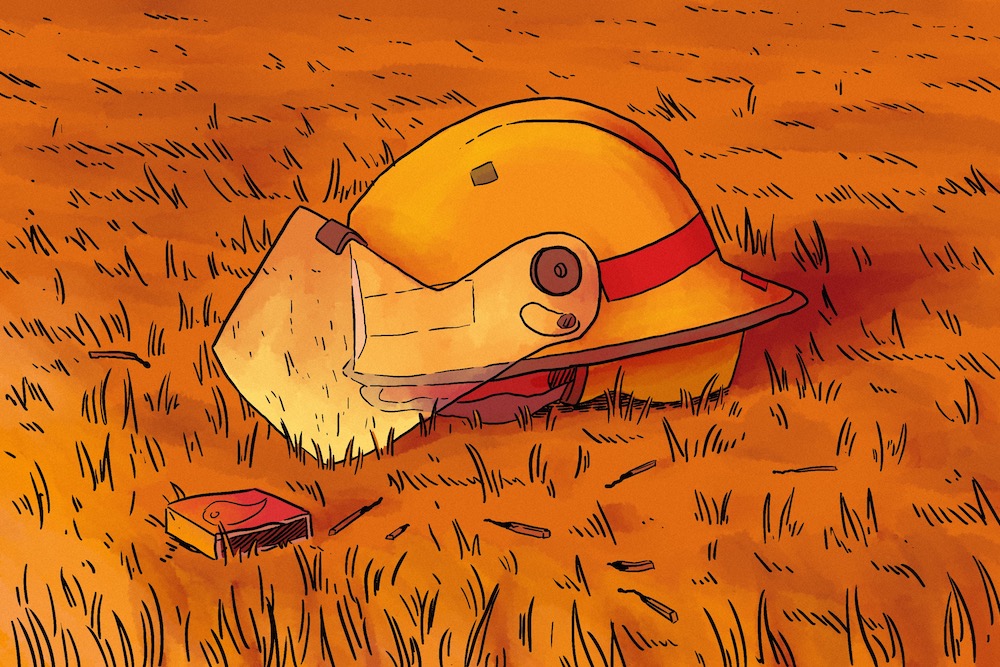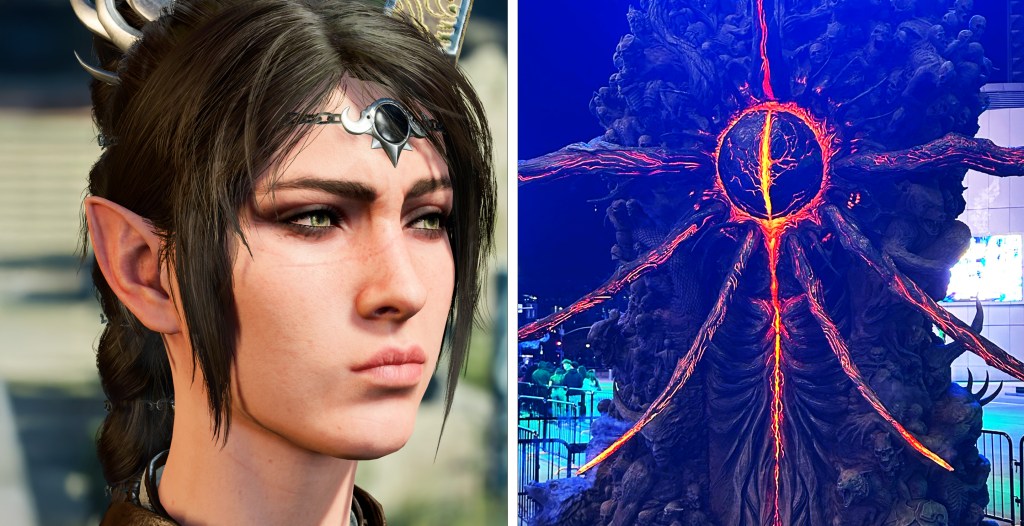This article is a longform version of the latest episode of our podcast “Extremes.” To hear the actual interview, check out Extremes on Apple, Spotify or wherever you get your podcasts.
Note: this article contains references to sexual assault.
Videos by VICE
We were sitting at a kitchen table at his mum’s place when David told me about his first bushfire. It was nearly 30 years earlier, but he could still clearly remember lighting it.
“I just threw some matches on the ground,” he said. “I had a packet of Redhead matches and I used half the box just flicking them around. I waited until there was flame, and then I drove away.”
From there, David headed to the fire station where he worked as a volunteer and spent the next 10 minutes opening the roller doors and getting the trucks started. By the time the town’s sirens went off, he was ready to go. The rest of the crew arrived a few minutes later and they climbed into the trucks and headed for the national park, back the way David had just come.
“When I left, the area that was burning wouldn’t have been any bigger than this table,” he said, motioning to the kitchen table. “But a few hours later it was several kilometres long.”
It took the rest of the day to get the blaze contained. Later, when the job was done, the captain put a big meaty hand on David’s shoulder and said “you did well mate,” which was feedback he’d always wanted but never received. And in that moment, David decided he’d do anything to feel valued like that again.
***
For a long while, I’d been obsessed with the question of who deliberately lights bushfires. To me, the question became important in February 2009, after the Black Saturday bushfires destroyed large swathes of my home state and killed 173 people. Not long after, a 39-year-old guy named Brendan Sokaluk was arrested under suspicion for lighting one of the day’s biggest fires. Sokaluk eventually received 17 years in prison for 10 counts of arson—one for each of the 10 people who died in his fire.
I personally knew people who’d escaped that fire. Chief among them were my friend’s parents who survived by wading into a farm dam as the blaze roared over their home. I remember hearing how they’d stood in the water up to their necks, watching as their home’s LPG gas cylinders exploded in the heat, blasting holes through the roof.
After that, my friend’s family left the state and moved to Perth. Like many, they decided there was too much heartbreak in Victoria.
In the years since, words like “firebug” and “pyromania” routinely caught my eye. The idea that someone would deliberately light a fire on a gusty afternoon, then drive away and let their fire arbitrarily kill dozens—that idea seemed incomprehensible. And so I spent years looking for news stories that might provide a window into the psychology of arson, without much luck.
Most newspaper reports included just a location and a description of the fire. If anyone was taken in for questioning, their names usually got withheld. Most importantly though, arsonists almost never spoke to the media, and in the one or two times they did, it was only to deny lighting fires. And so my question—who lights bushfires?—remained unanswered.
For this reason, I made it my personal mission to find a convicted arsonist who’d talk, so in early 2015 I began poring through old court documents looking for names. Once I’d compiled a list, I used social media to track people down and ask for interviews. For about a year I received nothing but refusals and ghostings, until one day I got a text from the guy I’m calling “David” in this story. He told me he’d been arrested lighting bushfires as a teen, back in the late 80s, and if I wanted to know more I could come visit him at home.
***
Australia is home to the most flammable landscapes in the world. California’s scrub-filled canyons are also primed for fire, but not to the same degree. Here, our forests are dominated by Eucalyptus trees, which for tens of thousands of years have relied on wildfire to aid in seed germination, and have encouraged fires by filling their leaves with volatile oils. Of course, modern society puts a lot of effort into suppressing fire, but Australia’s ecology hasn’t changed. Our summers are still hot and dry; the flora remains highly flammable, and these factors provide an opportunity for anyone drawn to waging relatively effort-free destruction.
According to data, lots of people in Australia are drawn to destruction. One study produced by the Australian Institute of Criminology found some 13 percent of all forest fires are classified as “deliberate.” But as arsonists rarely get caught, a further 37 percent of fires remain “suspicious,” meaning it’s statistically likely that arson is the single greatest cause of bushfires in Australia. As the study notes: “for all vegetation fires for which there is a cause recorded, 50 percent may be lit deliberately.”
These findings were pulled from a total of 280,000 fires over five years. So even if we assume that less than half are deliberate, that’s still a large number of people lighting fires—and a pretty scary portrait of faceless lunacy around the country.
These days, thanks to research after Black Saturday, the criminal profile for bushfire arson is fairly well defined, but to my way of thinking, unsatisfyingly clinical. We know arsonists are usually men at an average age of 26, with a disconcerting number volunteering with the country’s fire fighting agencies. They also tend to be disconnected from friends and family and live with depression or mental illness.
As I discovered, David ticked most of these boxes.
This article is a longform version of the latest episode of our podcast “Extremes.” To hear the actual interview, please subscribe to Extremes on Apple, Spotify or wherever you get your podcasts.
***
I won’t reveal where David lived, as this was a condition of our interview, but I will say he lived in a Victorian weatherboard with a row of lavender out the front. I pulled up along the nature strip and David appeared on the porch, waving enthusiastically. He was a bit over 5ft, with sandy hair, and a grin that made me think of children on Christmas cards. He was in his late 40s but seemed young—not in a creepy way, but in a way that made me want to make sure he’d had enough for breakfast. I watched him bound over to the car with an outstretched hand and a pair of orthopedic shoes clumping across the lawn, and I thought: he isn’t what I imagined.
David explained that he lived with his mum, who’d gone out for the day to give us some space. He acknowledged it wasn’t cool to live with his mum, but admitted they both needed the company, and then I followed him into a house filled with family portraits and porcelain knick-knacks. Looking around, I got the feeling David’s life had moved pretty slowly since his adolescence.
We sat down at the kitchen table and David began to talk. He’d been a happy kid, growing up along the southeast coast with a family of sisters and loving parents. He described himself as outgoing and optimistic—until the age of 12 when everything changed.
“That was when I had a major event happen,” he explained carefully, looking at the ceiling. “That was: I was raped by my best friend.”
Without prompting, David told me the story of going to the beach with two older boys, one of whom pinned him down while the other raped him.
David became a different person after that. He didn’t tell anyone what happened, he just spent lots of time in his bedroom, plotting revenge and watching TV. He says his mum knew something was up and tried to talk but he brushed her off. The only thing that finally cut through was his dad signing him up as a junior firefighter, which gave him a distraction. Sexual assault had made him feel worthless, but working with the fire crew gave him a purpose.
“I suddenly felt I was being part of the community,” he said. “I’d help with fundraising, go down the street and jiggle the buckets. It gave me a sense of belonging I suppose.”
Like a lot of the guys, his favourite part of the job was putting out the fires, which were few and far between—until one day David had an idea. He was sitting through a burn-off planning session, watching their captain point to areas on a map that needed preemptive burning to reduce fuel loads, and David wondered what would happen if he got in early. To his thinking, these areas were getting burned anyway, so there’d be no harm in setting them alight. Then he and the team would get a fun afternoon of guaranteed fire fighting.

“I realised if I lit the fires, I could be the first one at the fire station every time. I’d be the first person to unlock everything and get things ready to roll for when the others turned up. And then I knew where we were going, every time. It would be my little secret, and it made me feel powerful.”
David didn’t want to commit to a full-on bushfire without practice, so he began spending afternoons in the bush around town, testing ignition techniques. He’d take a bag of candles, matches, and flammable liquids to see which methods started which kinds of fires. Finally he decided candles were the way to go because they burned slowly, giving him time to escape.
At first David says his pyromania wasn’t about aggression. It was just about wanting to put out fires with the team, and getting praise from the captain. And in that sense, his first bushfire was a success—as described at the start of this article—so he lit another a few weeks later, and then another not long after that.
His modus operandi was always the same: he’d borrow his mum’s car, drive out to a patch of nearby national park, and throw some lit candles about. He’d then make sure the understory was alight, before fleeing for the fire station.
Over the summer of 1987, David’s hobby metastasised from a once-a-month diversion to a once-a-week necessity. Soon he was lighting fires every time he’d had a bad day—not for a sense of belonging, but for a feeling of power. Before long he was lighting fires simply for the rush of reducing a forest to ash, and that rush became addictive.
“The worst times were in winter,” he said. “I needed to light fires in winter, but I couldn’t get them going, so the frustration of not being able to light fires in winter exploded in spring and summer. And then I needed to make sure I got enough of a fix in summer because I knew I couldn’t get it in winter.”
Somehow he got through that first summer without killing anyone, but as 1988 came to a close and it grew warm again, the town saw another surge of bushfires. When I asked David how many fires he lit that second summer—the summer he was caught—he paused to think. “I don’t know,” he said. “Twenty? Thirty? It could have been up to 50.”
David was busted a few days before his 18th birthday. Fire station management had begun to suspect they had a firebug in town, and everyone was keeping watch. When someone finally recognised David’s mum’s car trundling back from a fire, they called the fire station captain, who told the caller to keep quiet. He’d personally go see David and take the teen to the police station.
For David it ended when his captain showed up on his doorstep and told him he’d been caught. This stung, but not as bad as being told he was no longer a member of the fire service. The two of them then drove to the police station.
Being 17 years old, David started by telling the police he knew nothing of the town’s spate of fires, and one of the officers responded by clubbing his head with a phone book, at which point he confessed to everything. From there David received a series of evaluations from psychologists, who ultimately recommended he was unfit for prison—which is probably why the magistrate eventually sentenced him to 250 hours of community service and a year of mandatory counselling.
Had David been caught lighting fires in 2019, he would have gone to prison. But in 1988 the word “arsonist” had received significantly less airtime, and a political thirst for mandatory internment was yet to emerge. So the court took a rehabilitative approach, and David received weekly counselling sessions, which gave him space to discuss his sexual assault.
“I’m glad I got caught,” he explained. “I was on a destructive path and if I hadn’t been caught, it frightens me to think what would have happened.”
David’s fires never destroyed any property nor injured anyone, as far as he knew, but he admitted they could have done both. He said he was sorry, but when I asked about regret he shook his head. “This might surprise you,” he said. “But I don’t regret what I did, because it allowed me to get counselling.”
David explained that the whole reason he agreed to my interview was because he wanted the public to better understand arson. He wanted people to know that arson generally isn’t malicious, but is a cry for help from damaged, traumatised people; people who carry their own versions of David’s sexual assault story.
I finished by asking him how he thought society should deal with arson, and those behind it, and unsurprisingly he thought the answer lay in mental healthcare.
“We need to get to arsonists before they become arsonists,” he told me. “People who have gone through trauma feel they can’t talk to anybody. But if their friends and family check in with them more, mental illness can be diagnosed quicker. It took seven years in my case, but it could have happened in months or just weeks.”
As the afternoon slid into twilight we shook hands in the front yard, and I drove home feeling kind of flat. I had my answer about why people light fires. It was an obvious answer, and if I had to guess it was probably the one I’d have predicted. But what I hadn’t foreseen was how David’s story provided an insight into the national prevalence of misery.
“I think trauma is pretty common,” he quipped before I left. “Maybe that’s why there are so many fires.”
Follow Julian on Twitter and Instagram
Listen and subscribe to Extremes on Apple, Spotify or wherever you get your podcasts.
More
From VICE
-

Screenshot: Larian, X @shinobi602 -

Gene Siskel and Roger Ebert (Photo by Norm Staples/Getty Images) -

One of the finalists, "Now Which Direction Is My Nest?" (Credit: Alison Tuck) -

Credit: Google
